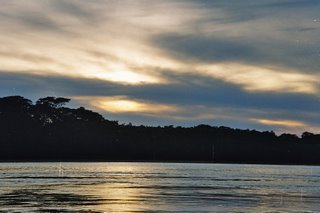Llamas in the mist
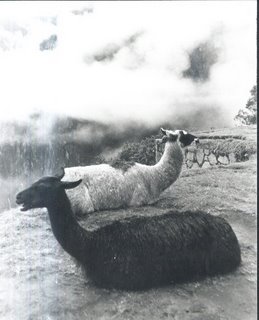
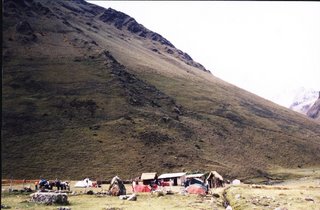
Camping for real

Break Time
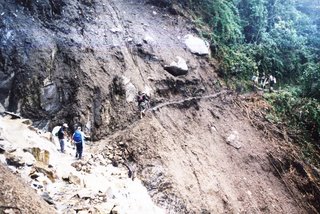
Don't look down
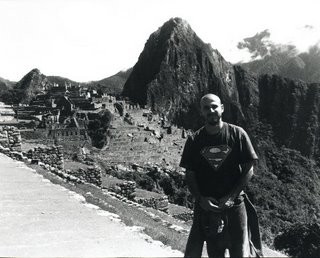
Macchupichu
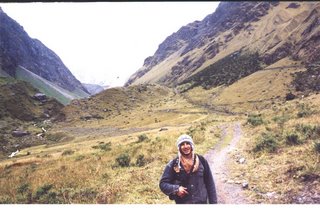
Towards 15,000 feet above sea level
Good sales man: Cristiano. Cristiano was the guy who saw me at the bus terminal and took me to the hostel where I stayed for two days, He also sold me the ticket to the Salcantay. He was very determined on his sales actions and called and visited the hostel several times to make sure I was considering his offer for this trip. He had everything for the tourist: two day tourist package, three days, four days, downtown visits, Inca trail, MacchuPichu, artesans’markets, you name it. I visited some agencies and then told Cristiano. “I have that too. How much they offered you?, I give it for five percent less, seven percent less…” Cristiano doesn’t work for a specific agency, he is a broker, he takes his sales to the agency offering what the tourist is looking for.
April 24, 2006
I was up at 4:30 am, a guy from the tourist agency will pick me up at five in the morning. This guy showed up in a taxi at six. He still had alcohol breath and told me we had to get two more guys. He didn’t have the address but he said he was on a ‘meeting’ the night before and his colleagues told him the name of the hostels he had to go to pick up the tourists. I had a great full-hour tour of downtown Cusco, the guy couldn’t find the second hostel. After riding up and down on the taxi, knocking on some of this guy’s friends doors to find out about the hostel address, asking different hostels near the neighborhood if that was the one, we finally went to the office which was already open. We got to the hotel and the couple, Laurent, from France and Onya, from Ireland, had to be woken up since they had gone back to bed thinking they were forgotten and had to think what to do for the next five days. I was a little ashamed to answer I was born in Peru when we introduced ourselves. When these acts of irresponsibility occur I take them very personal since I would like for some people of this country to take business more seriously. “I was up at four looking for your places” the agent told us. “That’s not my problem” said Laurent with a French accent. “You should have stopped drinking earlier” Onya added. We stopped then back at the office to pick up some of the equipment. We got to the bus terminal to take the shuttle to Mollaypata where our trekking adventure would start. Of course the bus was gone since it was close to eight in the morning and we were supposed to be there at six. We had to wait a little longer because I realized they had forgotten my sleeping bag, one of them went back to the office in the city to get it. The agents got us a taxi and they paid for the one-hour ride to Mollaypata. There were three more guys waiting for us over there.
There were five more groups at the plaza of Mollaypata. Each group had between five and nine members. There was even a group from the British army. All the guides were arranging with cooks and muleteers for a good price. When we got there, a local lady was complaining because she wanted all the tour guides to take her horses as carriers. Another local guy was arguing with her and saying he didn’t have to do business with her. I shortly found out this another guy was Walter, our tour guide. Everything was sorted out and we started walking. Katie, from Australia, John and Tanya a couple from England were very flexible and understanding about we being late. Cusco is at 3,250 meters (10,660 feet) above sea level. Mollaypata is at 3,600 meters (11,800 feet) above sea level, and our first camping stop this day was going to be 3,900 meters (12,795 feet). We left about 8:30 and the first hour of walking was not too bad. The group was walking always together or in pairs to get to know each other. I talked a lot also with Walter. He had dark skin, pony tail and about 1.65 meters tall (5”5 feet) and he spoke very good English considering he has never being in an English speaking country. He learned it just by talking to the tourists over eight years. As we kept walking we felt the shortness of breath. We had some high treks and then flat surface which we used to take breaks and wait or be waited. It was a little hot too, about 23 celsius (80 Farenheit), so we sweated easily. We all had bottles of water along the way but we couldn’t keep it for long because it turned warm quickly and we were only surrounded by mountains and trees and abysses. Due to the altitude I felt as I if I had a block of ice in the middle of my chest. The lack of oxygen made me inhale very deep breaths trying to fill my lungs as much as possible. This altitude impact can become serious. It may turn into soroche or altitude sickness. It may make you dizzy, your stomach gets upset and you vomit and get diarrhea, you start feeling weak and sleepy, your legs quiver and it is really hard to stand on your feet. We passed the other groups and were sometimes passed by others. This was not a competition but there were times that I didn’t like when I was passed and felt the need to be ahead of someone when I was very close to them, I felt good passing them and leaving them behind. The five of us quickly started acting as a group and look back anytime we felt one of us was missing. This first day was to acclimatize to the altitude although two members of the British army got, after two hours of walking, the soroche, Another army guy had heard me speaking in Spanish with Walter so he approached me, sweating and venting, and explained to me that two of his partners had gotten sick and he need me to be his interpreter since their guide didn’t speak English. The group I was in comprehended the situation and waited for me until I was done helping the army guys. Walter also came along. We talked to a truck driver who was going back to Mollaypata and asked him to take these two Britts to the stop right before the campsite. All the groups would stop there for lunch, besides that was the last point accessible for trucks. I managed to reduce the ride price for these guys down to twenty five percent of what the driver was asking for, not bad considering my poor negotiating skills. The guys were taken away and we all continued our hike. After a couple more hours we got to the lunch site and we sat by a reef overlooking the green mountains and blue skies filled with cotton balls look-alike clouds and applied lots of repellent. We got to the campsite by five thirty. Carl, the English guy who approached me to help him with his two ill friends, asked me once more to help him talk to campsite owner to get some horses for next day. After several minutes of pulling and pushing on prices we settled the transaction. They needed two horses for each of the guys who were sick but wanted another one to carry their bags. The cook and the muleteer told me they wanted to carry the soldiers’ belongings so they could get the money offered for the third horse as porters. I looked at them, I translated it for Carl, Carl accepted, I translated it back to the new porters, they smiled and thanked me and Carl. On dinner time Carl showed up with two big “Cusqueñas”, the beer brewed in Cusco. I considered that a good payment for my services and shared them with the rest of my group.
April 25th, 2006
We woke up at six in the morning, it was cold considering it was the last days of summer on the south of the American continent, about 4 C (36 F). . The cook prepared breakfast, hot chocolate, bread with butter and a power bar. We put the tents away and the muleteer started to pack them on one of his two horses. By six thirty we took off. The Salcantay pass is at 4,600 meters (15,091 feet) and the idea was to get there around eleven in the morning. The Britain army guys had left earlier since they were trying to avoid the midmorning heat. Onya went out quick like she was on a mission. Katie needed also a horse so Walter was with her. The rest of us walked almost together. We took some pictures of the Salcantay all covered with snow as the mist at the bottom of it made it look like an iceberg sticking out between two mountains. Salcantay means something like “Annoyed goat” in quechua. And one of the guides told me that it makes sense since this mountain has never been climbed to its peak. People who have tried have died on their intents. We started to zig-zag the pass. Walter gave us some coca leaves to chew since that is used to give you energy and battle the soroche. I chewed a couple of times but decided to go without it. I wanted to test my body reactions. None in our group chewed. My head was hurting a little as we started to hike up and we had to take several breaks before continuing. I checked my pulse often and whenever I stopped for a break I was on 108 heartbeats per minute. I felt like I had just finished a race. We carried a little stone to put it on a small pyramid as a sign of accomplishment. By ten forty five we were on the top of the pass, we saw several pyramids built by other hikers whenever they got to this stage. We took some breath, celebrated our achievement by hugging and cheering and posed in front of our pyramid for the picture. We looked around, it was not a sunny day so it was hard to see the mountain clearly but winds moved the mist a bit and we could take a glance of part of the mountain. After we ate our lunch sitting by a small river and having still some fog around we started our descent to the next campsite. There were now trees and green areas, mountains were also covered by trees and some mudslides marks. It started to get a little warmer and mosquitoes appeared forcing us to apply our repellents once more. I decided to walk at the end of the group this time enjoying the breeze and the view and going easy on my knees that were a little sore. A small noisy river run along the hike making the whole scene surreal.
By time we got to the campsite we were really tired. All these days we were going to sleep by eight.
April 26,2006
It was raining in the morning. The road was wet and muddy. Our guide Walter told us the road was very narrow and was on mountains so we had to walk carefully to avoid ending up on the river, which was about 60 meters (190 feet) down. These are roads few people walked so it can be unsteady on some parts. These roads are not Incas so there is little maintenance to them. When the rain cleared, it got sunny and humid. I have never been in more than one place where the temperatures and geography change so abruptly and so quick. Once we got to the lunch site we took our shoes and lay down on the grass, well, we did this every time we had lunch breaks. We decided to get a couple of beers since this was the only lunch stop where we had a convenience store. We saw three more groups including the British Army guys, the two that were ill were already walking better. The horses at this point were not used anymore since we had to take a cargo truck to get to the next stop. Samuel, our muleteer, had lunch with us and said goodbye. He had to come back the same way. Our lunches have been very well prepared. I thought we were going to eat sandwiches everyday since they are a lot easier to carry and prepare but to my surprise we ate soups, chicken, fish, rice, salads and fruit juice everyday. Our cook then was an expert packing and cooking on the middle of nowhere and he had everything he needed since day one. He used one horse to carry all his cooking materials: bowls, plates, utensils, glasses, cups. The muleteer used the other horse to carry the tents, sleeping bags and a big tent that was used as kitchen. We carried our own backpacks. I had, this time, only my small backpack since I had my lesson on Isla del Sol, I left the big one at the hostel in Cusco. After lunch and three beers we got in to the cargo truck, on the cargo side, and rode standing with some locals to our last campsite Santa Teresa, a small town. We were dropped by a restaurant and while the cook stayed to prepare dinner we went to the hot springs to relax. The way to get to this hot springs was very challenging. They were just building and new road so we had to cross a section with mud and rocks. We all were on flip-flops since we thought we didn’t have to hike anymore. We managed to cross with the help of some kids and once we paid for our entrance we used the rest of the evening (4-6pm) to swim and enjoy.
April 27th, 2006
I walked around Santa Teresa before taking breakfast. I saw some kids going to school and workers beginning their days. I wanted to imagine how it would be to live there, what would I do, where would I work, who would my friends be. We walked towards the river which we had to cross by sitting in a small iron-cage hanging from a cable. The river was a good 70 meters (229 feet) wide. Once you are pushed by the person who is next in line you feel kind of vulnerable watching the river underneath, with brown colors and going fast and furious. Once on the other side we walked a good four hours, we went around a damn which holds some water from the Urubamba river. It was a truck road that we took, so the road was wide and comfortable to walk on. Being so flat makes the trekking a little long, and once we got to the ferroviaria, where a train that takes people to Aguas Calientes, we had our last lunch cooked by our “chef”, Bonifacio. We were not surrounded by only nature anymore. We used a table that was on the patio of a small inn, the table had covers on, a convenience store where some other tourists bought ice cream and sodas. Several vendors were sitting also around the rail tracks selling their products. It was inevitable to realize that our hiking adventure was losing some primitive magic. We took then the route of the train, we walked on the tracks and stopped and moved one time to watch the train passed. This railroad felt longer than when we walked on the truck road but we were again on jungle area. We applied again some more repellent and we stopped to watch the Urubamba river, fast and furious, on our right side everytime we could. We got to Aguas Calientes around 4:30pm, a city that has grown with no order. There were internet stores, restaurants, hotels, artesans’ vendors all around but very clean. It is hard to recognize a local person from this city as well since there are so many tourists. The tourists usually stay one night only since they go back to Cusco after going to Machupichu. I run into some people I met in Uyuni – Bolivia. We were split then to be taken to different hostels. My room had two beds and private shower, I missed that little tent that night. We got together again at the hotel where I was and went out for some drinks before dinner, we walked around, bought some snacks for the next day and took it easy. I went to a birthday party of a tour coordinator who invited me but stayed there just for about an hour. I went to bed around ten at night to start our last day next day at four in the morning.
April 28th, 2006
I was woken up around two in the morning by the noise of a drunk guy who was vomiting at the bathroom. I went down the stairs and told him and his friend to go their room and let the rest of us sleep. They were two local guys and I still think they saw the hostel open and decide to use the guestroom. One of the group member knocked at my door at four and I dressed and then went to get breakfast. We said goodbye to our cook Bonifacio and tipped and thanked him for his great work and exquisite cuisine that we had over the past four days.
We started walking around four forty five in the morning. Flashlights on hand and bottles of water again. The bottom of this hill was about half hour from the hostel. We were the first group going and saw some local people jogging too, without flashlights. We started hiking this hill and even though we knew we were on about 2,700 meters we knew we had to get to the 3,300 in an hour and half. We knew some parts of this hill would give us an idea that we were hiking almost vertically. We didn’t take many breaks and we turned the flashlights off after about half hour of hiking. It was getting clear and we could see parts of the mountains. I didn’t know how was going to be the view of Machupichu but I tried to imagine how it was when the Incas where alive, and how it is that after so many years people still travel far, walk for days and camp in the middle of nowhere to come here. As it got clearer and we sweated more we wanted to be there, if felt like we had to hike forever, we heard some buses going up. They charge you eight US dollars to take you on this comfortable, air-conditioned bus to the entrance of Macchupichu in fifteen minutes. After one hour and ten minutes we approached the entrance. We were soaking wet, a perfect morning workout. We saw a bunch of buses coming full of people and some hikers were just getting there too. Our tour guide gave us our tickets and we entered, among the other hundreds of people into Machupichu. We all wanted to see the sunrise but it was very cloudy, we had to walk some trails before turning left and watch right in front of our eyes what that cloudy morning gave us. Mist and peace. We took pictures of some domesticated llamas. I snacked something as breakfast and just sat to wait for the mist to go away. It was around six thirty and there were hundreds of people already walking, sitting, eating, filming, waiting. Around seven the winds blew and we started to see the shape of the Huaynapichu, the mountain behind Machupichu, which has been the center of millions of postcards around the world and since its discovery in 1,911. Walter explained some simple facts about this place. We took the rest of the morning to walk around, touch the walls and try to fantasize about the way people lived here on the fourteen hundreds. The architecture is almost perfect, the way the stones were cut, carved and allocated in such a way that it has remained almost intact for all these years. The many centers, entrances, animal sacrifices centers, praying centers, agriculture area, all this on top of these mountains. The Intiwatana, the center where a stone was located in such way that the Incas could tell the time of the year to calculate harvest time based on the shadow this stone would give based on the position of the sun. Some of group decided to climb the Huanapichu, I stayed walking around and watching this magnificent picture. Green mountains, the sound of the river and the clicking of cameras. If the time machine existed, this will be the second place I would like to visit to check the lifestyle of its habitants.
This is the second time I have come to Machupichu, but this time was the way I always wanted to do it: by walking. The parties in the clubs and the ruins on the rest of the city, which is beautiful and has plenty of history, was not the main intention of my visit to Cusco. If I have one complaint it would be the expensive prices of the tours and the many agencies that there are on this town. I think the differences of what a local and a foreign tourist pay is also ridiculous, this comes along with the treatment people get. The tourist is usually overcharged or ‘robbed’ while the local pays less but it is treated very poorly. I alone decided to take the local train back to Cusco but I had to go standing in a wagon that was oversold. I had to give space to people that wanted to go to the bathroom and to the lady who was selling snacks up and down since I was right on the alley. Gringos have to pay ten times more than cholos for a comfortable wagon….simply ridiculous

